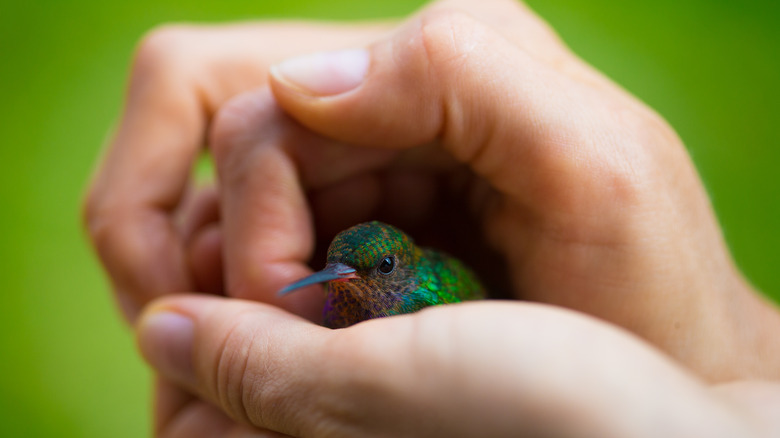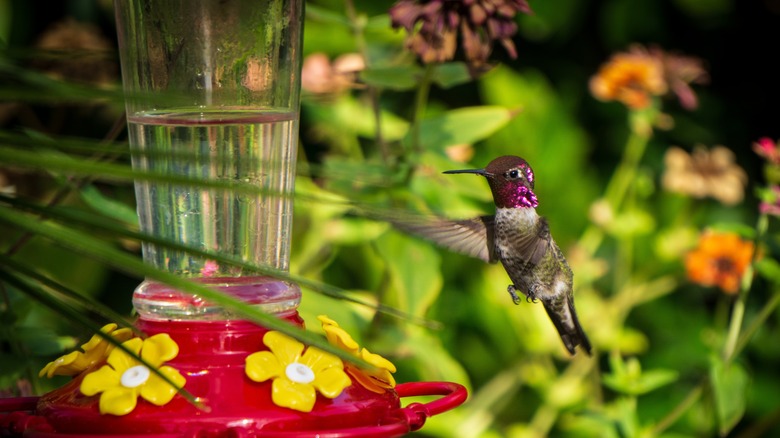Are Your Garage Lights Luring Hummingbirds Inside? Here's What You Should Know
Hummingbirds are frequent visitors to North American gardens, arriving throughout the spring months. If you are a garage owner, and you have experienced a hummingbird flying into your garage at night when the lights are on, you may think this is because they are attracted to artificial lights. However, there is no evidence to suggest this is the case. In fact, hummingbirds typically do not fly at night. Unlike moths, who are drawn to artificial light after dark, hummingbirds have vision that is finely adapted for navigating during the daylight hours, and not so well-adapted for night vision. Like all birds, hummingbirds use the sun as their compass during the daytime. This is also how hummingbirds will keep coming back to your garden during migration each year to enjoy your flowers and feeders.
If you do find a hummingbird has flown into your garage, it may be because they spotted a brightly colored object — not garage lights. They are attracted to red, purple, yellow, and orange, though it may even be a color that you cannot see. Hummingbirds have four color cone types in their eyes (humans have only three), allowing them to see ultraviolet colors. Bright colors in or near your garage may invite hummingbirds to venture inside. They may also be looking for a safe spot to build a nest. The best thing to do if you find a hummingbird in your garage and it cannot get out is to carefully remove it.
How to safely remove a hummingbird from your garage
Unfortunately, it's not uncommon to find a hummingbird trapped in your garage. When this happens, it may be difficult for them to find their way back out. This seems to be because, when they are inside a building, their instinct is to fly upward, making it difficult for them to get themselves to move forward toward the exit. Should you need to rescue a trapped bird, there are several things you can do to safely help a hummingbird that's stuck in your garage or other building.
Firstly, open your garage door or any other doors and windows that lead outside to see if it can find its way out. Moving bright-colored items outside can also help. If the hummingbird is still unable to leave, you may have to offer further assistance. If you have a rake or broom handy, cover the tines or brush head with a towel and hold it up in the air near the hummingbird. Be patient; you may have to wait until the tiny creature is almost exhausted. When the bird lands, it will allow you to slowly carry it outside, where it will fly away to find somewhere safe to sleep before nightfall.
Making your yard safe for hummingbirds
To stop hummingbirds coming into your garage, first keep it closed when not in use. Invite them into your yard instead by planting colorful flowers such as hosta, bee balm, trumpet honeysuckle, and salvia. Hummingbirds have a metabolism that is 77 times faster than us, so they need to feed all day long to keep up energy. Red hummingbird feeders can also draw them in. Their preferred food ? Nectar made from sugar and water. You can buy it or make your own by adding ¼ cup of white sugar to one cup of boiling water. Stir until all the sugar has dissolved. During the summer, you should rinse your feeder thoroughly and replace the nectar twice a week. It will last around a week in cooler weather. You can also bring the charm of hummingbirds to your garden with this easy DIY swing.
Once the sun begins to set, hummingbirds will seek out shelter to sleep safely, so keep your garage shut then. If you see one sleeping, you may be surprised to find it hanging upside down. Although this isn't their normal sleeping position, sometimes they slip into a state known as torpor. This occurs when their bodily functions, such as breathing and heart rate, slow down dramatically. Hanging upside down is not a problem for a hummingbird, and as soon as it wakes, it can easily right itself. Once hummingbirds are well-rested, they are ready to return to their search for nectar.


